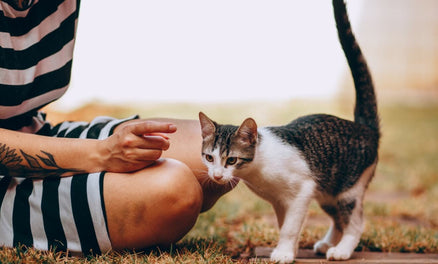by Alexander Thompson
Aug 15, 2022
2 minute read
TABLE OF CONTENTS
- Cat Body Language Explained
- Cat Body Languages and Meanings
- Communicating with Your Cat Through Body Language
- In Conclusion
Like humans, cats also have their body language. These sweet furry creatures communicate in various complicated
ways. Sometimes, your cat just wants to be alone. Other times, she may want to move close to you and get really
cozy. Understanding these, and by extension, learning cat body language, will strengthen your relationship with
your furry ball.
Cats have fewer facial muscles than dogs, which means they are less expressive. Picking up the slightest signs
and changes in their body language will require a lot of focus. This article will explain cat body language and
how you can understand and read it.
Cat Body Language Explained
Any non-verbal means of communication your cat adopts to show how they feel is
her body language. The evolution of the domestic cat makes them different from the African Wildcat in terms of
communication. The wild cats hardly express their pains or fears because it gives them away to predators or
stronger cats. Therefore, it is very typical for cats to hide how they feel.

Cat Body Languages and Meanings
As mentioned earlier, reading your cat’s body language will not always be a straightforward task. You must pay
close attention to her posture, mouth, and eyes to understand her psychology.
Happy Cat
A happy cat sits relaxed and upright. The eyes are also relaxed but pointed up and forward. When lying down, she
may tuck her paws tidily underneath. She may also lie on her side or back fully stretched out.
Bothered Cat
A bothered cat adopts a crouched position with tense muscles and a tight body. She tucks her tail tightly into
her body with the ears slightly tilted sideways. She may lower her head or tuck it into her body. You can see
the tension on her face, especially with dilated pupils.
Stressed Cat
The easiest way to identify a stressed or anxious cat is her body responses. From shaking to trembling, hissing,
and guttural meowing, an agitated cat will always look different from a calm cat. Sometimes, she may lose
control of her bowels and bladder.
Frustrated Cat
A frustrated cat puts all her attention on the source of frustration and will do everything she can to have her
way. She focuses all her senses on the task at hand, and if things are not going her way, she will pace
impatiently around the area.

Angry Cat
You can quickly identify an angry cat with her rigidity. The tail stays stiff under her body, straight or curled
around. The threatening looks on her face, rigid front legs, and erect furs are the signals you need to stay
away from an angry cat.
Click to learn more about how to help your cat with anxiety.
Communicating with Your Cat Through Body Language
Communication with your cat becomes much better when you understand what she is trying to express through her
body language. If your cat shows signs of comfort and relaxation, you can respond similarly by blinking at them
while tilting your head to the side. Cats are quick to replicate body languages that reflect how they feel.
In Conclusion
Cats love attention, but they can get really playful and may scratch you without any warning. They are also
rebellious - your feline friends enjoy disobeying commands even if they take their time to learn and understand
such commands. This interesting nature of cats puts you in the position to learn how to interpret their unusual
body language and behavior. With these, you can easily understand how they are feeling and how best you can help
them at any point in time.
SUBSCRIBE
Subscibe for our newsletter to get updates on the latest products, offers, and more.
CATEGORIES

























